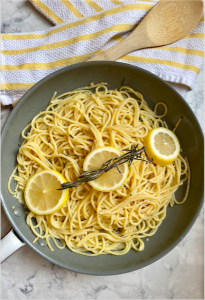Nutritional Content and Health Benefits
Fresh rosemary contains vitamin A, vitamin C, calcium, and potassium [i]. In traditional folk medicine, rosemary has been used to treat inflammation in the body, digestive issues, and cardiac disorders [ii]. In addition to vitamins and minerals, rosemary contains polyphenols such as diterpenes, carnosic acid, and rosmarinic acid. These polyphenols have been shown to have anti-cancer effects by preventing cell growth and increasing cell death [iii].
How to Use
Depending on the recipe, you can cook with the entire rosemary sprig. You will want to remove the sprig before eating as it is tough and can be a choking hazard. If you want to avoid cooking with the whole sprig, remove the sprig’s needles and mince the needles. This will prevent any choking risk, and you can toss in the rosemary to your dish. Lastly, dried rosemary is an excellent alternative to using fresh rosemary. The flavor of this herb can be overwhelming. For one serving of your dish, start with ½ a sprig, and you can adjust the flavor as you like.


- 8 ounces dry pasta
- 1 sprig of rosemary, minced
- ¼ cup olive oil
- 1 garlic clove, diced
- 1 lemon, juiced
- 1 zest of lemon
- 2 tablespoons heavy cream
- Boil a large pot of water and cook pasta according to package directions. Once pasta is finished cooking, set aside. Do not drain the pasta from the water.
- In a large sauté pan over medium to medium-low heat, add the olive oil and stir in rosemary. Let rosemary and oil become hot, about 1 minute.
- Add in garlic, lemon juice, lemon zest, and heavy cream. Whisk together until uniformly combined. Let sauce become hot, about 1-2 minutes.
- Using tongs, transfer pasta from the pot into the sauté pan.
- Mix pasta into the sauce until well-coated. If there is not enough sauce, add a tablespoon of pasta water.
- Divide past into three bowls, adjust seasoning as needed. Garnish with rosemary.
- This rosemary lemon pasta is a great recipe if you are looking to gain weight or experiencing a low appetite. To increase fiber content, try whole wheat pasta.
[i] “Rosemary, fresh Nutrition Facts & Calories.” Self Nutrition Data. Retrieved from https://nutritiondata.self.com/facts/spices-and-herbs/224/2
[ii] Achour M, Bravo L, Sarriá B, et al. Bioavailability and nutrikinetics of rosemary tea phenolic compounds in humans. Food Research International. Published online October 20, 2020:109815. doi:10.1016/j.foodres.2020.109815
[iii] Moore J, Yousef M, Tsiani E. Anticancer Effects of Rosemary (Rosmarinus officinalis L.) Extract and Rosemary Extract Polyphenols. Nutrients. 2016;8(11):731. doi:10.3390/nu8110731
